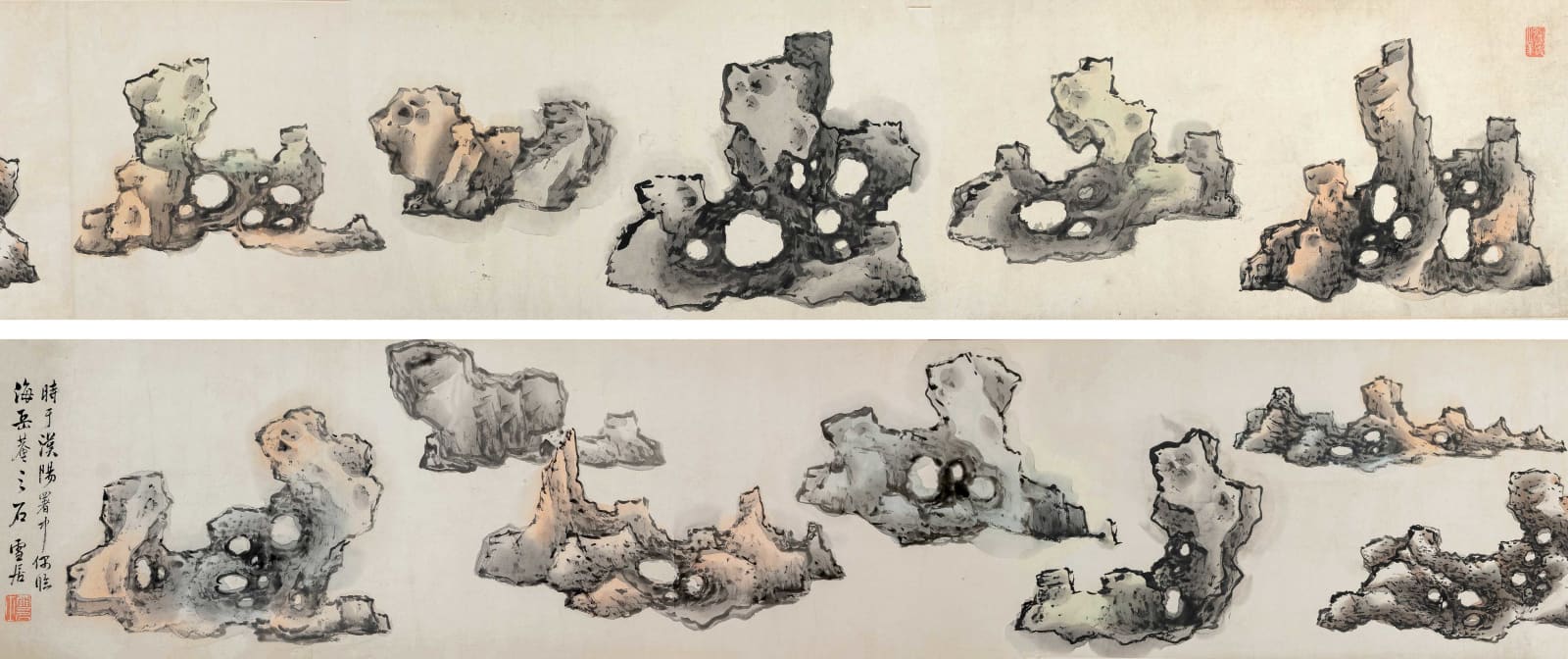-
Artworks

Sun Kehong (1532-1610)
Wondrous RocksInk and color on paper, Handscroll11 1/4 x 108 3/4 in
28.6 x 276.2 cmSun Kehong (1532-1610), styled Yunzhi, and known as Xueju, was the son of Sun Cheng'en (1482-1561), the Minister of Rites during the Jiajing era of the Ming dynasty. Sun Cheng'en...Sun Kehong (1532-1610), styled Yunzhi, and known as Xueju, was the son of Sun Cheng'en (1482-1561), the Minister of Rites during the Jiajing era of the Ming dynasty. Sun Cheng'en served as the chief examiner in the imperial examination in the 26th year of the Jiajing Reign, becoming the teacher of many important Ming officials such as Li Chunfang (1510-1584), Yang Jisheng (1516-1555), Zhang Juzheng (1525-1582), and Wang Shizhen (1526-1590). Although Sun Kehong inherited an official position as the prefect of Hanyang through his father's influence, his early experiences in office led him to see through the darkness of the bureaucratic world, and he was unwilling to become a victim of political struggles. Consequently, he returned to his hometown in Songjiang, where he continued to renovate his father's "Dongguo Thatched Cottage," transforming it into a manor for his reclusive life. There, he leisurely entertained guests and pursued his calligraphy and painting. Famous literati of the Songjiang region, such as Mo Shilong (1539-1587), Dong Qichang (1555-1636), and Chen Jiru (1558-1639), were frequent visitors.
The "Dongguo Thatched Cottage" was so well renovated that it even made Dong Qichang envious. Dong expressed his admiration on Sun Kehong's "Seven Rocks" scroll, housed in the Beijing Palace Museum, saying, "I will gift him a painting by Mi (Mi Fu, 1051-1107), only wishing to exchange for a piece of the brilliant clouds in front of Dongguo Thatched Cottage; that would suffice." Sun Kehong was primarily known for his flower and bird paintings, but his rock works not only inspired Dong Qichang to write inscriptions for them but also influenced other painters like Lan Ying (1585-1664) in their creation of rock paintings.
The scroll "Wondrous Rocks” showcases such influence. It depicts twelve rocks of varying postures, arranged near and far, standing or lying, with colors ranging from deep to light. Some resemble distant landscapes, some look like Mi Fu's inkstones, and others appear as if they were taken from a landscape painting, each inviting prolonged contemplation. According to the inscription, Sun Kehong created this piece while still serving as an official in Hanyang, making it one of his early works. The original models for these rocks were likely from the stones collected and cataloged by Mi Fu. From a painting perspective, this work is somewhat different from Sun Kehong's other rock styles, using shorter lines and dots with drier ink. However, this style of painting provided a clear stylistic source for Lan Ying's rock paintings. As one of the first literati Lan Ying visited in the Songjiang region, Sun Kehong not only offered Lan Ying the opportunity to meet people like Dong Qichang but also provided significant intellectual guidance for Lan Ying's later creations.
孙克弘(1532-1610),字允执,号雪居。他的父亲是嘉靖朝礼部尚书孙承恩(1482-1561),曾在在嘉靖二十六年的会试作为主考官成为李春芳(1510-1584)、杨继盛(1516-1555)、张居正(1525-1582 )及王世贞(1526-1590)等多位明朝重臣的座师。孙克弘虽然承袭父荫官至汉阳太守,但是为官初期的一些经历让他看透了官场的黑暗,不愿意再当政治斗争的牺牲品。于是他回到家乡松江,在父亲「东郭草堂」的基础上继续修葺,使其变成了自己归隐生活的庄园,并在其中悠闲会客同时进行书画创作。当时松江地区的著名文人如莫是龙(1539-1587)、董其昌(1555-1636)和陈继儒(1558-1639)等,都是他的常客。 「东郭草堂」修葺的如此之好,让董其昌都为之羡慕,并在北京故宫博物院藏孙克弘《七石图》轴上写到「余将以米画赠之,惟欲易东郭草堂前一片艳霞,便意足也。」孙克弘主要是以花鸟画闻名于世,但他的石头作品不仅感染了董其昌为其题跋,更是影响了蓝瑛(1585-1664)等其他画家关于石头的创作。
本件《奇石图》卷就体现这样的影响力。此卷描绘了十二颗姿态各异的石头,它们或近或远排布,形态或立或卧,颜色或深或浅。有的如江山远眺,有的神似米芾之砚山,还有的像某幅山水画中挖下来的一块石头,每一块都可以让观者品味良久。根据款识我们知道孙克弘创作此件作品时还在汉阳做官,是以为其早年作品。而这些石头的原型则应来自于米芾收藏过并刊刻入书的石头。从绘画角度来说,这件作品由于使用的短线条和点比较多,且用墨比较干燥,与其他孙克弘的石头风格略有不同。但这样的画法反而为蓝瑛画石头的风貌提供了很明显的风格来源。作为蓝瑛最早到松江地区所拜访的文人名士,孙克弘不仅为蓝瑛提供了结交董其昌等人的机会,更是对蓝瑛日后的创作提供了很多思想上的指导。
Provenance
Publications
This Single Feather of Auspicious Light: Old Chinese Painting and Calligraphy. Vol. 1, London: Sydney L. Moss. Ltd., 2010, #13
Join our mailing list
* denotes required fields
We will process the personal data you have supplied to communicate with you in accordance with our Privacy Policy. You can unsubscribe or change your preferences at any time by clicking the link in our emails.

